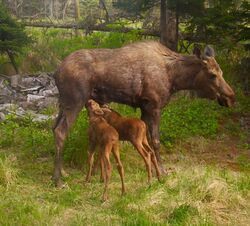Biology:Milk immunity
Milk immunity is the protection provided to immune system of an infant via the biologically active components in milk, typically provided by the infant's mother.
Mammalian milk
All mammalian milk contains water, sugar, fat, vitamins, and protein with the variation within and between species and individuals differing mainly in the amount of these components.[1] Other than the variation in quantity of these components, not a lot is known about bio-active or immune-modulating factors in many mammalian species. However, in comparison to other mammalian milk, human milk has the most oligosaccharide diversity.[2]
Bovine milk
Ruminant mothers do not transfer immunity to their infants during pregnancy, which makes milk the first introduction to maternal immunity calves receive.[3] Bovine milk contains both immunoglobulins A and G, but in contrast to human milk where IgA is the most abundant, IgG is more abundant.[4] Secretory Component, IgM, both anti-inflammatory and inflammatory cytokines, and other proteins with antimicrobial functions are also present in bovine milk.[3]
Human milk
Avian crop milk
Crop milk is a secretion from the crop of a bird that is regurgitated to feed their offspring.[5] Birds that produce this secretion include pigeons, flamingos, emperor penguins, and doves.[6] Pigeon milk contains some immune-modulating factors such as microbes and IgA, as well as other components with similar biological activities to mammalian milk including pigeon growth factor, and transferrin.[7]
References
- ↑ Power, Michael L.; Schulkin, Jay (2016). The Biology of Lactation Milk. Baltimore, Maryland: Johns Hopkins University Press. pp. 4. ISBN 978-1-4214-2043-1.
- ↑ Martin, M.A.; Sela, D.A. (2013). "Infant Gut Microbiota: Developmental Influences and Health Outcomes". in Clancy, KB. Building Babies. New York: Springer. pp. 233–256. doi:10.1007/978-1-4614-4060-4_11. ISBN 9781461440598.
- ↑ 3.0 3.1 "Immune components of bovine colostrum and milk". Journal of Animal Science 87 (13 Suppl): 3–9. April 2009. doi:10.2527/jas.2008-1377. PMID 18952725.
- ↑ "Immunoglobulin A in Bovine Milk: A Potential Functional Food?". Journal of Agricultural and Food Chemistry 63 (33): 7311–6. August 2015. doi:10.1021/acs.jafc.5b01836. PMID 26165692.
- ↑ Eraud, Cyril; Dorie, Adrien; Jacquet, Anne; Faivre, Bruno (2008). "The crop milk: a potential new route for carotenoid-mediated parental effects". Journal of Avian Biology 39 (2): 247–251. doi:10.1111/j.0908-8857.2008.04053.x. ISSN 1600-048X. https://hal.archives-ouvertes.fr/hal-00294461/file/Eraud2008.pdf. Retrieved 2022-06-14.
- ↑ Power, Michael L.; Schulkin, Jay (2016). "Feeding Offspring". The Biology of Lactation Milk. Baltimore, Maryland: Johns Hopkins University Press. pp. 26–27. ISBN 978-1-4214-2042-4.
- ↑ "Functional similarities between pigeon 'milk' and mammalian milk: induction of immune gene expression and modification of the microbiota". PLOS ONE 7 (10): e48363. 2012-10-26. doi:10.1371/journal.pone.0048363. PMID 23110233. Bibcode: 2012PLoSO...748363G.
 |


